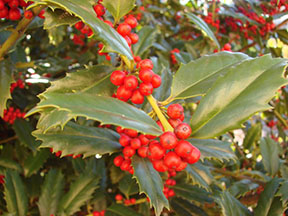 HOLLY: Holly is an extremely hardy shrub that can be grown in all fifty states of the United States, making it one of the few plants that can withstand temperatures from 110 degrees F to - 40 degrees F. The four hundred species of holly, ranging from dwarf holly plants six inches high to huge holly trees seventy feet tall, are native to all the continents except Antarctica and Australia. Holly plants are noted for their attractive red berries and glossy, sharp-toothed green leaves which remain on the plant year round. The holly bush represents immortality, a trait that God has given to each human being. We are all destined to live forever, either with the Lord or separated from Him. The sharp-toothed edge of the holly leaf reminds Christians of the crown of thorns with which the soldiers mocked Our Lord during His Passion. They laughingly hailed Him as king, never realizing that He is, indeed, King of the universe. As a Christmas symbol, the red holly berry represents Christ's blood, shed for all people including those who reject Him.
HOLLY: Holly is an extremely hardy shrub that can be grown in all fifty states of the United States, making it one of the few plants that can withstand temperatures from 110 degrees F to - 40 degrees F. The four hundred species of holly, ranging from dwarf holly plants six inches high to huge holly trees seventy feet tall, are native to all the continents except Antarctica and Australia. Holly plants are noted for their attractive red berries and glossy, sharp-toothed green leaves which remain on the plant year round. The holly bush represents immortality, a trait that God has given to each human being. We are all destined to live forever, either with the Lord or separated from Him. The sharp-toothed edge of the holly leaf reminds Christians of the crown of thorns with which the soldiers mocked Our Lord during His Passion. They laughingly hailed Him as king, never realizing that He is, indeed, King of the universe. As a Christmas symbol, the red holly berry represents Christ's blood, shed for all people including those who reject Him.
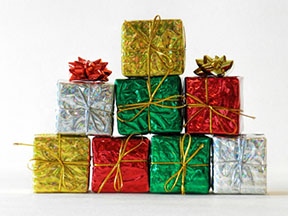 GIFTS: For many people, gifts define Christmas. They focus on the giving and receiving of gifts instead of on our greatest gift, Jesus, who gave Himself to us at Christmas. The wise men who brought their gifts of gold, frankincense, and myrrh to honor the infant King in Bethlehem's manger have inspired the concept of gift giving at Christmas. God also gives us the gifts of the Holy Spirit which help us to follow God's direction in our lives. The seven Gifts of the Holy Spirit are Wisdom, Understanding, Counsel, Knowledge, Piety, Fortitude, and Fear of the Lord (Awe of God's Greatness and Power).
GIFTS: For many people, gifts define Christmas. They focus on the giving and receiving of gifts instead of on our greatest gift, Jesus, who gave Himself to us at Christmas. The wise men who brought their gifts of gold, frankincense, and myrrh to honor the infant King in Bethlehem's manger have inspired the concept of gift giving at Christmas. God also gives us the gifts of the Holy Spirit which help us to follow God's direction in our lives. The seven Gifts of the Holy Spirit are Wisdom, Understanding, Counsel, Knowledge, Piety, Fortitude, and Fear of the Lord (Awe of God's Greatness and Power).
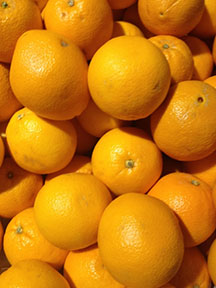 FRUIT: People give fruit baskets as gifts. Cranberry sauce is part of many Christmas meals. At the turn of the last century, good children would receive their only orange of the year as a Christmas gift. As a Christmas symbol, fruit recalls the twelve Fruits of the Holy Spirit. These Fruits result from the activity of the Gifts of the Holy Spirit in our lives. The twelve Fruits of the Holy Spirit are: Charity (Love), Joy, Peace, Patience, Benignity (Kindness), Goodness, Long-Suffering (Patiently Bearing Suffering over a Long Period of Time), Mildness, Faith, Modesty, Continency (Purity), Chastity.
FRUIT: People give fruit baskets as gifts. Cranberry sauce is part of many Christmas meals. At the turn of the last century, good children would receive their only orange of the year as a Christmas gift. As a Christmas symbol, fruit recalls the twelve Fruits of the Holy Spirit. These Fruits result from the activity of the Gifts of the Holy Spirit in our lives. The twelve Fruits of the Holy Spirit are: Charity (Love), Joy, Peace, Patience, Benignity (Kindness), Goodness, Long-Suffering (Patiently Bearing Suffering over a Long Period of Time), Mildness, Faith, Modesty, Continency (Purity), Chastity.
 MISTLETOE: Mistletoe is an aerial parasite that has no roots of its own. It lives off the tree to which it attaches itself and, without that tree, it would die. Mistletoe is a Christmas symbol of our love which derives from and exists only because God loves us. God, Who is Love, created us in love and caused us to be able to love. Christians are humbled before these words of St. John the Evangelist: “God is love, and he who abides in love abides in God and God abides in him” (1 Jn. 4:16). Just as mistletoe may not acknowledge the tree which sustains it, so people may not acknowledge that the love of God sustains them. But if mistletoe were taken from the tree and any person removed from God’s love, both would die.
MISTLETOE: Mistletoe is an aerial parasite that has no roots of its own. It lives off the tree to which it attaches itself and, without that tree, it would die. Mistletoe is a Christmas symbol of our love which derives from and exists only because God loves us. God, Who is Love, created us in love and caused us to be able to love. Christians are humbled before these words of St. John the Evangelist: “God is love, and he who abides in love abides in God and God abides in him” (1 Jn. 4:16). Just as mistletoe may not acknowledge the tree which sustains it, so people may not acknowledge that the love of God sustains them. But if mistletoe were taken from the tree and any person removed from God’s love, both would die.
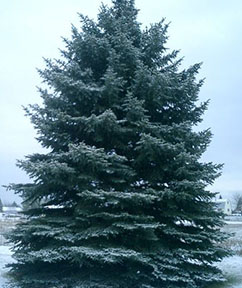 EVERGREENS: In cool climates, many plants are deciduous. That is, they lose their leaves in the fall, remain dead-looking all winter, and begin to sprout new growth in the spring. Evergreens are, broadly speaking, any type of plant that retains its green leaves or needles all year round. As Christian Christmas symbols, evergreens symbolize perseverance and resiliency to adversity. They remind us of Jesus' words, "The ones who persevere to the end shall be saved." Our faith must remain vibrant in all spiritual, economic, political, and social environments.
EVERGREENS: In cool climates, many plants are deciduous. That is, they lose their leaves in the fall, remain dead-looking all winter, and begin to sprout new growth in the spring. Evergreens are, broadly speaking, any type of plant that retains its green leaves or needles all year round. As Christian Christmas symbols, evergreens symbolize perseverance and resiliency to adversity. They remind us of Jesus' words, "The ones who persevere to the end shall be saved." Our faith must remain vibrant in all spiritual, economic, political, and social environments.
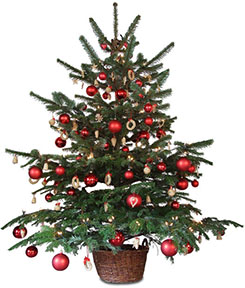 CHRISTMAS TREE: Many pagan cultures worshipped evergreens, saw them as symbols of immortality, and used them to ward off evil spirits. In the early 700’s, Saint Boniface, who converted the German people to Christianity, demolished the Oak of Thor, the mighty sacred tree worshipped by the Saxons. From its roots grew a fir tree which Boniface took as a sign of the Christian faith. In the 11th century, Paradise plays portrayed the tree of Paradise, decorated with red apples. During the 15th century, the faithful began to erect trees in their homes on December 24, the feast day of Adam and Eve. About the year 1500, Martin Luther, inspired by a snow covered fir tree, brought a small tree indoors and decorated it with candles in honor of Christ’s birth. By the 18th century, the custom of decorating a Christmas tree was well established in France, Germany, and Austria. Thus, the Christmas tree represents the original Tree of Paradise, the burning bush which spoke to Moses, the branch of Jesse from which Jesus was born, the life-giving tree of the cross of Christ, and the tree which St. John the Apostle saw in the Book of Revelations whose leaves have medicine for the people and which yields fruit each month for the healing of the nations. Because it is green year-round, the evergreen tree represents hope. Its needles and its narrow crest point upward, turning our thoughts to heaven. Because the tree is cut down and then erected again, it is a symbol of Christ’s resurrection.
CHRISTMAS TREE: Many pagan cultures worshipped evergreens, saw them as symbols of immortality, and used them to ward off evil spirits. In the early 700’s, Saint Boniface, who converted the German people to Christianity, demolished the Oak of Thor, the mighty sacred tree worshipped by the Saxons. From its roots grew a fir tree which Boniface took as a sign of the Christian faith. In the 11th century, Paradise plays portrayed the tree of Paradise, decorated with red apples. During the 15th century, the faithful began to erect trees in their homes on December 24, the feast day of Adam and Eve. About the year 1500, Martin Luther, inspired by a snow covered fir tree, brought a small tree indoors and decorated it with candles in honor of Christ’s birth. By the 18th century, the custom of decorating a Christmas tree was well established in France, Germany, and Austria. Thus, the Christmas tree represents the original Tree of Paradise, the burning bush which spoke to Moses, the branch of Jesse from which Jesus was born, the life-giving tree of the cross of Christ, and the tree which St. John the Apostle saw in the Book of Revelations whose leaves have medicine for the people and which yields fruit each month for the healing of the nations. Because it is green year-round, the evergreen tree represents hope. Its needles and its narrow crest point upward, turning our thoughts to heaven. Because the tree is cut down and then erected again, it is a symbol of Christ’s resurrection.
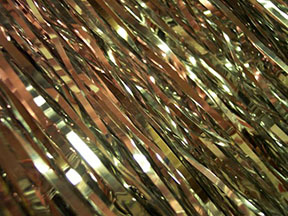 TINSEL: Tinsel are the thin, metallic strands that are used in Christmas decorations. A legend tells of a poor, faithful family who wished to decorate a Christmas tree in honor of the Christ Child but who had no money for decorations. In the night, spiders came and spun webs across the tree. Then the Christ Child, honoring the family's faith, turned the threads into silver. When we want to give our all to Christ, but we think that we have nothing of value to give, God gives value to our offerings. God does not measure worth by worldly standards but by spiritual ones. Give Christ your all and He will consider it more precious than gold.
TINSEL: Tinsel are the thin, metallic strands that are used in Christmas decorations. A legend tells of a poor, faithful family who wished to decorate a Christmas tree in honor of the Christ Child but who had no money for decorations. In the night, spiders came and spun webs across the tree. Then the Christ Child, honoring the family's faith, turned the threads into silver. When we want to give our all to Christ, but we think that we have nothing of value to give, God gives value to our offerings. God does not measure worth by worldly standards but by spiritual ones. Give Christ your all and He will consider it more precious than gold.
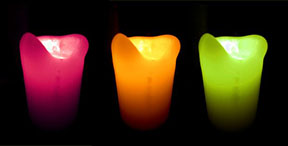 CANDLES AND CHRISTMAS LIGHTS: In the Advent wreath, a purple (for penance) candle is lit for the first, second, and fourth Sundays of Advent and a pink (for joy) one for the third Sunday of Advent. On Christmas Day, a white (for the purity of Christ) candle is lit in the center of the wreath. Before electricity, people used candles to light their homes and to decorate their Christmas trees. Today electric lights have replaced candles. Candles and Christmas lights represent Christ, the Light of the World. "I am the light of the world. No follower of mine shall ever walk in darkness; no, he shall possess the light of life" (John 8:12). "The light shines on in the darkness, a darkness that did not overcome it" (John 1:5). Candles and Christmas lights also remind us that we are to be light to others, to show them the way to Christ.
CANDLES AND CHRISTMAS LIGHTS: In the Advent wreath, a purple (for penance) candle is lit for the first, second, and fourth Sundays of Advent and a pink (for joy) one for the third Sunday of Advent. On Christmas Day, a white (for the purity of Christ) candle is lit in the center of the wreath. Before electricity, people used candles to light their homes and to decorate their Christmas trees. Today electric lights have replaced candles. Candles and Christmas lights represent Christ, the Light of the World. "I am the light of the world. No follower of mine shall ever walk in darkness; no, he shall possess the light of life" (John 8:12). "The light shines on in the darkness, a darkness that did not overcome it" (John 1:5). Candles and Christmas lights also remind us that we are to be light to others, to show them the way to Christ.
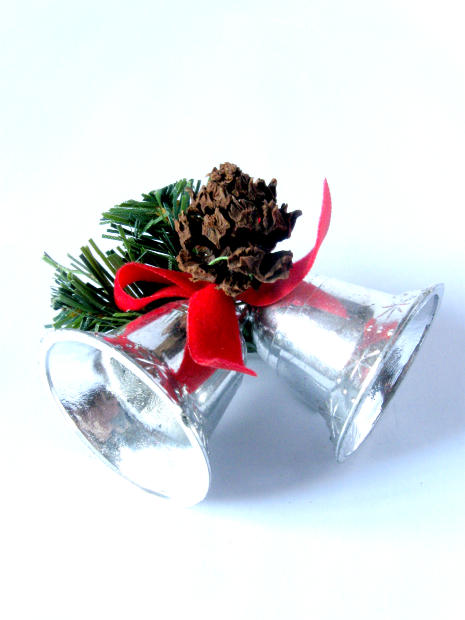 BELLS: Bells were part of the Jewish high priest's garb. God gave these instructions to Moses: The robe of the ephod you shall make entirely of violet material. It shall have an opening for the head in the center, and around this opening there shall be a selvage, woven as at the opening of a shirt, to keep it from being torn. All around the hem at the bottom you shall make pomegranates, woven of violet, purple and scarlet yarn and fine linen twined, with gold bells between them; first a gold bell, then a pomegranate, and thus alternating all around the hem of the robe. Aaron shall wear it when ministering, that its tinkling may be heard as he enters and leaves the LORD'S presence in the sanctuary; else he will die. (Exodus 28:31-35). Christmas bells not only symbolize the joy of Christmas; they also remind us that Christ is the High Priest. Those priests were many because they were prevented by death from remaining in office, but he [Jesus], because he remains forever, has a priesthood that does not pass away. Therefore, he is always able to save those who approach God through him, since he lives forever to make intercession for them. It was fitting that we should have such a high priest: holy, innocent, undefiled, separated from sinners, higher than the heavens. He has no need, as did the high priests, to offer sacrifice day after day, first for his own sins and then for those of the people; he did that once for all when he offered himself. (Hebrews 7:23-27).
BELLS: Bells were part of the Jewish high priest's garb. God gave these instructions to Moses: The robe of the ephod you shall make entirely of violet material. It shall have an opening for the head in the center, and around this opening there shall be a selvage, woven as at the opening of a shirt, to keep it from being torn. All around the hem at the bottom you shall make pomegranates, woven of violet, purple and scarlet yarn and fine linen twined, with gold bells between them; first a gold bell, then a pomegranate, and thus alternating all around the hem of the robe. Aaron shall wear it when ministering, that its tinkling may be heard as he enters and leaves the LORD'S presence in the sanctuary; else he will die. (Exodus 28:31-35). Christmas bells not only symbolize the joy of Christmas; they also remind us that Christ is the High Priest. Those priests were many because they were prevented by death from remaining in office, but he [Jesus], because he remains forever, has a priesthood that does not pass away. Therefore, he is always able to save those who approach God through him, since he lives forever to make intercession for them. It was fitting that we should have such a high priest: holy, innocent, undefiled, separated from sinners, higher than the heavens. He has no need, as did the high priests, to offer sacrifice day after day, first for his own sins and then for those of the people; he did that once for all when he offered himself. (Hebrews 7:23-27).
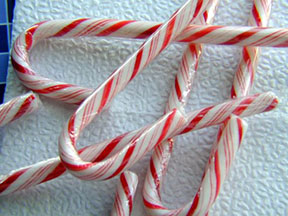 CANDY CANE: The candy cane is shaped like a shepherd's crook, reminding us that Jesus, the Good Shepherd, came into our world at Christmas. The red stripe symbolizes Christ's sacrifice and the white background His purity. Candy canes have a peppermint flavor, reminiscent of hyssop which had medicinal purposes. The Psalmist prayed, Lord, cleanse me with hyssop that I may be clean (Psalm 51:9). Jesus came to heal our ills and to purge us of sin. The peppermint flavor reminds us that our healing came at the price of Christ's life. When Jesus was crucified, a bystander stuck a wine-filled sponge on a branch of hyssop to give Jesus a drink. After tasting the wine, Jesus said, "Now it is finished," and died (John 19:29-30). The candy cane is meant to be broken and shared, just as Jesus' Body is broken and shared at every Eucharist.
CANDY CANE: The candy cane is shaped like a shepherd's crook, reminding us that Jesus, the Good Shepherd, came into our world at Christmas. The red stripe symbolizes Christ's sacrifice and the white background His purity. Candy canes have a peppermint flavor, reminiscent of hyssop which had medicinal purposes. The Psalmist prayed, Lord, cleanse me with hyssop that I may be clean (Psalm 51:9). Jesus came to heal our ills and to purge us of sin. The peppermint flavor reminds us that our healing came at the price of Christ's life. When Jesus was crucified, a bystander stuck a wine-filled sponge on a branch of hyssop to give Jesus a drink. After tasting the wine, Jesus said, "Now it is finished," and died (John 19:29-30). The candy cane is meant to be broken and shared, just as Jesus' Body is broken and shared at every Eucharist.
 GINGERBREAD MAN: The gingerbread man does not create himself but rather is created. Gingerbread people remind us of God's creation of Adam in the Garden of Eden, and God's creation of each of us. Spices, reminiscent of those mentioned in the Old Testament, make the gingerbread man the color of earth (Adam was created from the dust of the earth). Like us, gingerbread people are not immortal. They are destined to be eaten and thus to unite with their creators. God does not eat us (rather we consume His Body and Blood in the Eucharist), but our mortal bodies, like that of the gingerbread man's, will not live forever. God created us for eternal union with Him after we die. Gingerbread people remind us to look beyond ourselves to our Creator with whom we will one day be united.
GINGERBREAD MAN: The gingerbread man does not create himself but rather is created. Gingerbread people remind us of God's creation of Adam in the Garden of Eden, and God's creation of each of us. Spices, reminiscent of those mentioned in the Old Testament, make the gingerbread man the color of earth (Adam was created from the dust of the earth). Like us, gingerbread people are not immortal. They are destined to be eaten and thus to unite with their creators. God does not eat us (rather we consume His Body and Blood in the Eucharist), but our mortal bodies, like that of the gingerbread man's, will not live forever. God created us for eternal union with Him after we die. Gingerbread people remind us to look beyond ourselves to our Creator with whom we will one day be united.
 SANTA CLAUS: Santa Claus is a corruption of Saint Nicholas, fourth Bishop of Myra (located in modern Turkey) whose feast day is December 6. He is also called Saint Nicholas of Bari after his relics were taken to Bari, Italy, in 1087. Saint Nicholas was known for taking to heart Jesus' words about almsgiving. But when you give alms, do not let your left hand know what your right is doing, so that your almsgiving may be secret. And your Father who sees in secret will repay you. (Matthew 6:3-4) Saint Nicholas was very generous to the poor, but most often anonymously. The most famous story concerns three young women whose destitute father was going to force them into prostitution in order to survive. To prevent this heinous crime, Nicholas, on three different nights, anonymously went to their father's house and threw a bag of gold though an open window. The bishop's miter and fur trimmed red winter garments were corrupted into Santa's outfit, while Saint Nicholas's generosity was transferred to the "jolly old man" who delivers gifts anonymously on Christmas Eve.
SANTA CLAUS: Santa Claus is a corruption of Saint Nicholas, fourth Bishop of Myra (located in modern Turkey) whose feast day is December 6. He is also called Saint Nicholas of Bari after his relics were taken to Bari, Italy, in 1087. Saint Nicholas was known for taking to heart Jesus' words about almsgiving. But when you give alms, do not let your left hand know what your right is doing, so that your almsgiving may be secret. And your Father who sees in secret will repay you. (Matthew 6:3-4) Saint Nicholas was very generous to the poor, but most often anonymously. The most famous story concerns three young women whose destitute father was going to force them into prostitution in order to survive. To prevent this heinous crime, Nicholas, on three different nights, anonymously went to their father's house and threw a bag of gold though an open window. The bishop's miter and fur trimmed red winter garments were corrupted into Santa's outfit, while Saint Nicholas's generosity was transferred to the "jolly old man" who delivers gifts anonymously on Christmas Eve.
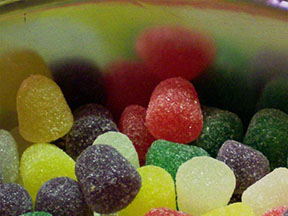 SUGAR AND CHRISTMAS CANDY: Everyone loves Christmas treats, most often sweetened with sugar. Sugar isn't found in Scripture and, for centuries, only the wealthy used it. The lower classes used honey or molasses as sweeteners. References to honey are found frequently in Scripture. God promised Abraham that he would bring his people to a "land of milk and honey," that is a rich and fertile homeland. The manna in the desert tasted "like wafers made with honey," a foretaste of the Eucharist which, although not sweetened with honey, is sweet to us spiritually because it is the Body of Christ. Isaiah prophesied concerning the Messiah, "the virgin shall be with child, and bear a son, and shall name him Immanuel. He shall be living on curds and honey by the time he learns to reject the bad and choose the good." Since curds and honey were abundant in a prosperous, peaceful land, they indicate that the virgin's son will bring peace. Curds and honey also refer to the "land of milk and honey" promised to Abraham. John the Baptist, who prepared Israel for the coming of Christ, lived on "locusts and wild honey." In the Book of Revelation, the little scroll "tasted like honey" in the Evangelist's mouth but turned bitter in his stomach, meaning that his call to prophecy seemed joyful at first but brought rejection later as commonly happens with prophets. The sweets we consume at Christmas remind us of the sweetness of God's Presence, come into the world on Christmas.
SUGAR AND CHRISTMAS CANDY: Everyone loves Christmas treats, most often sweetened with sugar. Sugar isn't found in Scripture and, for centuries, only the wealthy used it. The lower classes used honey or molasses as sweeteners. References to honey are found frequently in Scripture. God promised Abraham that he would bring his people to a "land of milk and honey," that is a rich and fertile homeland. The manna in the desert tasted "like wafers made with honey," a foretaste of the Eucharist which, although not sweetened with honey, is sweet to us spiritually because it is the Body of Christ. Isaiah prophesied concerning the Messiah, "the virgin shall be with child, and bear a son, and shall name him Immanuel. He shall be living on curds and honey by the time he learns to reject the bad and choose the good." Since curds and honey were abundant in a prosperous, peaceful land, they indicate that the virgin's son will bring peace. Curds and honey also refer to the "land of milk and honey" promised to Abraham. John the Baptist, who prepared Israel for the coming of Christ, lived on "locusts and wild honey." In the Book of Revelation, the little scroll "tasted like honey" in the Evangelist's mouth but turned bitter in his stomach, meaning that his call to prophecy seemed joyful at first but brought rejection later as commonly happens with prophets. The sweets we consume at Christmas remind us of the sweetness of God's Presence, come into the world on Christmas.